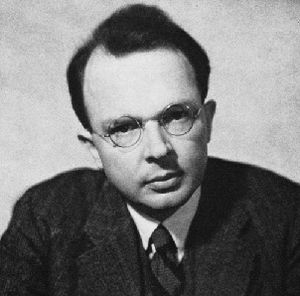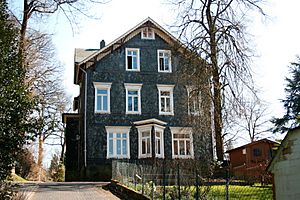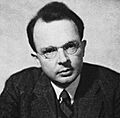Rudolf Carnap facts for kids
Quick facts for kids
Rudolf Carnap
|
|
|---|---|

Rudolf Carnap, 1935, by Francis Schmidt
|
|
| Born | 18 May 1891 |
| Died | 14 September 1970 (aged 79) Santa Monica, California, U.S.
|
| Education | University of Jena (B.A., 1914; PhD, 1921) University of Freiburg (audit student, 1911–12) University of Berlin (graduate research, 1917–18) University of Vienna (Dr. phil. hab., 1926) |
| Era | 20th-century philosophy |
| Region | Western philosophy |
| School | Analytic Nominalism Vienna Circle Logical positivism Logical atomism Logical behaviorism Formalism in the philosophy of mathematics |
| Institutions | University of Vienna University of Chicago Institute for Advanced Study UCLA |
| Theses |
|
| Doctoral advisor | Bruno Bauch (Ph.D. advisor) Moritz Schlick (Dr. phil. hab.) |
| Other academic advisors | Gottlob Frege Heinrich Rickert |
| Doctoral students | Abner Shimony David Kaplan |
| Other notable students | Carl Gustav Hempel Peter G. Ossorio Herbert A. Simon Raymond Smullyan Yehoshua Bar-Hillel |
|
Main interests
|
Logic · Epistemology Philosophy of science Semantics |
|
Notable ideas
|
List
Physicalism
Phenomenalism in linguistic terms Logical behaviorism Extensionalism Analytic–synthetic distinction (revised) Internal–external distinction Confirmationism Constitution theory Semantics for modal logic Inductive logic Constructed systems Conceptual schemes Formal epistemology Framework-relative constitutive a priori Intension and extension Functor Beobachtungssatz (observational statement) Carnap's categoricity (Monomorphie) problem Forkability theorem (Gabelbarkeitssatz): "every complete axiom system is also categorical (monomorph)" Logical positivism Epistemic structural realism L-true (logically true) statements Intensional semantics evaluating formulas in state-descriptions Carnap sentences Three kinds of space: formal, physical and perceptual Elimination of metaphysics through logical analysis Omega-rule General self-referential lemma Carnapian (concept) explication Principle of tolerance Compatibilism |
Rudolf Carnap (born May 18, 1891 – died September 14, 1970) was an important German-language philosopher. He worked in Europe until 1935, then moved to the United States. He was a key member of the Vienna Circle, a group of thinkers who believed in logical positivism. Carnap is seen as one of the most important philosophers of the 1900s.
Contents
Rudolf Carnap's Life Story
Rudolf Carnap's father owned a factory that made ribbons. His mother came from a family of academics. Her father was a reformer in education, and her oldest brother was Wilhelm Dörpfeld, a famous archaeologist. When Rudolf was ten, he even went on an expedition to Greece with his uncle Wilhelm. Carnap grew up in a very religious Protestant family, but he later became an atheist.
He started his schooling at the Barmen Gymnasium and the Carolo-Alexandrinum Gymnasium in Jena. From 1910 to 1914, he studied at the University of Jena. He planned to write a paper on physics. He also deeply studied Immanuel Kant's book Critique of Pure Reason. He was one of the few students to take Gottlob Frege's classes on mathematical logic.
During his university years, he became very interested in the German Youth Movement.
Carnap did not agree with World War I for moral and political reasons. However, he felt he had to serve in the German army. After three years, he was allowed to study physics at the University of Berlin from 1917 to 1918. Albert Einstein was a new professor there. Carnap then went back to the University of Jena. He wrote a paper about the rules of space and time. The physics department thought it was too much about philosophy. The philosophy department thought it was pure physics. So, Carnap wrote another paper in 1921. This one was about the theory of space in a more traditional Kantian style. It was published as Der Raum (Space) in 1922.
Frege's class introduced him to Bertrand Russell's work on logic and philosophy. This helped Carnap understand the goals of his studies. He wanted to improve traditional philosophy using new ideas in logic that could help science. He wrote to Russell, who copied parts of his important book Principia Mathematica by hand for Carnap. This was because Carnap and his university could not afford the book. In 1924 and 1925, Carnap attended classes led by Edmund Husserl. Husserl was the founder of phenomenology. Carnap continued to write about physics from a logical positivist point of view.
Carnap found a like-minded person when he met Hans Reichenbach at a conference in 1923. Reichenbach introduced Carnap to Moritz Schlick. Schlick was a professor at the University of Vienna. He offered Carnap a job in his department, which Carnap accepted in 1926. Carnap then joined a group of thinkers in Vienna. This group became known as the Vienna Circle. Schlick mostly led it. Other members included Hans Hahn, Friedrich Waismann, Otto Neurath, and Herbert Feigl. Hahn's student Kurt Gödel also visited sometimes. When Wittgenstein visited Vienna, Carnap would meet with him. Carnap, along with Hahn and Neurath, wrote the group's main statement in 1929. He also started the philosophy journal Erkenntnis with Hans Reichenbach.
In February 1930, Alfred Tarski gave lectures in Vienna. In November 1930, Carnap visited Warsaw. During these times, he learned a lot about Tarski's way of understanding semantics. Rose Rand, another philosopher in the Vienna Circle, noted that Carnap's idea of semantics built on Tarski's work. Carnap made a difference between logical and non-logical ideas. He also separated logical truth from factual truth.
In 1931, Carnap became a professor at the German University of Prague. In 1933, W. V. Quine met Carnap in Prague. They talked a lot about Carnap's work. This started a long-lasting respect between them. This respect continued even when Quine later disagreed with some of Carnap's ideas.
Carnap believed in socialist and pacifist ideas. These beliefs put him in danger in Nazi Germany. So, he moved to the United States in 1935. He became an American citizen in 1941. Back in Vienna, Schlick was murdered in 1936. From 1936 to 1952, Carnap was a philosophy professor at the University of Chicago. In the late 1930s, Carnap offered an assistant job to Carl Gustav Hempel. Hempel accepted and became one of Carnap's most important helpers. With help from Quine, Carnap spent 1939–41 at Harvard University. There, he met Tarski again. Carnap (1963) later said he was a bit annoyed about his time at Chicago. He and Charles W. Morris were the only ones in the department who believed science and logic were most important. Still, Carnap's years at Chicago were very productive. He wrote books on semantics (Carnap 1942, 1943, 1956), modal logic, and the ideas behind probability and inductive logic (Carnap 1950, 1952).
After working at the Institute for Advanced Study in Princeton (1952–1954), he joined the UCLA Department of Philosophy in 1954. Hans Reichenbach had died the year before. He had turned down a similar job at the University of California, Berkeley. This was because he would have had to sign a loyalty oath, which he disagreed with. At UCLA, he wrote about scientific knowledge, the analytic–synthetic distinction, and the verification principle. His writings on thermodynamics and the basics of probability and inductive logic were published after he died (Carnap 1971, 1977, 1980).
Carnap taught himself Esperanto when he was 14 years old. He always liked the language (Carnap 1963). He later went to the World Congress of Esperanto in 1908 and 1922. He used the language when he traveled.
Carnap had four children with his first wife, Elizabeth Schöndube. They divorced in 1929. He married his second wife, Elizabeth Ina Stöger, in 1933. Ina passed away in 1964.
Rudolf Carnap's Main Ideas
This section looks at the main ideas in Rudolf Carnap's philosophy. It highlights his most important works and how he helped shape modern epistemology (the study of knowledge) and philosophy of logic.
Understanding Space: Der Raum
From 1919 to 1921, Carnap worked on his PhD paper called Der Raum: Ein Beitrag zur Wissenschaftslehre (Space: A Contribution to the Theory of Science, 1922). In this paper, he explored the philosophical ideas behind geometry. Carnap wanted to give a logical base for a theory of space and time in physics.
Carnap was interested in pure mathematics, natural sciences, and philosophy. His paper tried to connect geometry, physics, and philosophy. He thought these fields often used the same words, like "space," but with different meanings. Carnap argued that disagreements about space happened because people were talking about different things.
He said there were three different ideas of space:
- "Formal" space is like space in mathematics. It's an abstract system of relationships.
- "Intuitive" space comes from our natural way of understanding things, not from specific experiences.
- "Physical" space is about real spatial facts we observe in the world.
This meant that these three types of "space" needed different ways of thinking and studying them. This paper showed some of Carnap's main ideas. He believed many philosophical problems came from using language incorrectly. He also stressed the importance of telling apart formal and material ways of speaking.
Building Knowledge: Der Logische Aufbau der Welt
From 1922 to 1925, Carnap worked on a major book called Der logische Aufbau der Welt (translated as The Logical Structure of the World, 1967). This book was accepted in 1926 as his qualification paper at the University of Vienna. It was published as a book in 1928. This work became very important in modern epistemology. It strongly supported the idea of logical positivism.
The Aufbau suggests that epistemology, which uses modern symbolic logic, should analyze scientific statements. Science itself, based on experience, is the only way to know about the outside world. Carnap believed that philosophical statements are about the language of science. They are not true or false. Instead, they are definitions and rules about how to use certain ideas. In contrast, scientific statements are facts about the real world. They are meaningful because they are based on what we perceive with our senses. We can check if these statements are true or false by testing them with more observations.
In the Aufbau, Carnap wanted to show how all scientific statements could be organized. He called this project "constitution theory." It's a way to organize scientific knowledge using symbolic logic. This system aims to find different types of scientific ideas and show how they are logically connected. In the Aufbau, ideas are things like objects, relationships, properties, groups, and states. Carnap argued that all ideas should be ranked in a hierarchy. In this system, ideas are organized so that complex ideas can be broken down into simpler ones.
Carnap explained that one idea can be reduced to another. This happens when all sentences with the first idea can be changed into sentences with the second idea. This means every scientific sentence should be able to be translated into another sentence. The original words should mean the same as the translated words. Most importantly, Carnap said that the base of this system is psychological. Its content is what is "immediately given." This means basic elements like our perceptual experiences. These basic elements are conscious mental states of a single person. Carnap believed his project showed that all scientific ideas could be defined and linked in one system. This system would be based on a few basic ideas.
Moving Beyond Metaphysics
From 1928 to 1934, Carnap published papers like Scheinprobleme in der Philosophie (Pseudoproblems in Philosophy, 1967). In these papers, he questioned the goals and methods of metaphysics. Metaphysics is a traditional type of philosophy that comes from old myths and religious ideas. Carnap thought that metaphysics often involved meaningless talks about "pseudo-problems."
For Carnap, a pseudo-problem is a philosophical question that seems to use ideas about our world. But in reality, these ideas don't refer to anything real or proven. These pseudo-problems are about statements that don't have any real-world effects. They don't talk about actual situations, and the things they mention cannot be observed.
So, one of Carnap's main goals was to change the purpose of philosophy. He believed philosophy should not try to create knowledge beyond what science already knows. Instead, philosophers should analyze the language of science. They should define the logical foundations of scientific knowledge. Using symbolic logic, they should explain the ideas, methods, and ways of proving things in science.
Carnap thought that traditional philosophy had problems because it used ideas that weren't useful for science. He doubted if these ideas were scientifically valid. This was because sentences using them didn't express facts. A logical look at these sentences showed they didn't describe real situations. In other words, these sentences were meaningless. Carnap explained that for a sentence to be meaningful, it must be factual. This can happen in two ways:
- It can be based on experience. This means it uses words related to direct observations.
- One can clearly state what observations would prove or disprove the sentence.
Carnap used a specific rule for meaning, called the Wittgensteinian principle of verifiability. This rule says that for a sentence to be meaningful, it must be verifiable. This means there must be a way to check if it is true or false. To check a sentence, you need to explain the real-world conditions that would show it is true.
Because of this, Carnap was clear that metaphysical sentences are meaningless. They include ideas like "god," "soul," and "the absolute." These ideas go beyond experience and cannot be linked to direct observations. Since these sentences cannot be checked in any way, Carnap suggested that science and philosophy should not include them.
Understanding Probability: Inductive Logic
After studying semantics (the study of meaning and truth, in books like Foundations of Logic and Mathematics, 1939; Introduction to Semantics, 1942; Formalization of Logic, 1943), Carnap focused on probability and inductive logic. His ideas on this topic are mostly in Logical foundations of probability (1950). Carnap wanted to give a clear logical explanation of probability.
Carnap thought that under certain conditions, probability should be seen as a purely logical idea. In this view, probability is a basic idea in all inductive reasoning. Inductive reasoning is when a conclusion is likely, but not definitely true, based on what you know. Carnap said that the problem of induction is about finding a clear explanation of the logical link between a guess (hypothesis) and the information that supports it (evidence). So, inductive logic is based on the idea that probability is a logical link between two types of statements: the hypothesis (conclusion) and the premises (evidence). A theory of induction should explain how, by just using logic, we can figure out if certain evidence strongly supports a hypothesis.
Carnap believed that science had both a logical and an experimental side. He thought it was important to separate the experimental parts from the logical parts of any knowledge. For example, the idea of frequency used in statistics describes how often things happen. This is different from the logical ideas of probability that just describe logical links between sentences. Carnap believed that statistical and logical ideas should be studied separately.
Because of this, Carnap defined two types of probability:
- The first is logical probability. It deals with how much a hypothesis is supported by evidence. This is called the degree of confirmation.
- The second is empirical probability. It relates to how often one observable thing in nature happens compared to another. This is called relative frequency.
Statements about relative frequency are about reality and describe actual situations. They are empirical. This means they must be based on experiments and observing facts. On the other hand, statements about the degree of confirmation don't say anything about facts. Their meaning can only be understood by looking at the symbols they contain. They are analytical sentences. This means they are true because of their logical meaning. Even if these sentences could refer to real situations, their meaning comes from the symbols and relationships they contain. In other words, the probability of a conclusion is given by its logical link to the evidence. So, figuring out the degree of confirmation for a hypothesis is a problem of understanding meaning.
The probability of a statement about relative frequency can be unknown. This is because it depends on observing things. You might not have enough information to know its exact value. So, such a statement can only be confirmed if it is supported by facts. In contrast, the probability of a statement about the degree of confirmation could be unknown. This might be because you don't have the right logical method to figure out its exact value. But, such a statement can always be given a logical value. This is because its value only depends on the meaning of its symbols.
Images for kids
See also
 In Spanish: Rudolf Carnap para niños
In Spanish: Rudolf Carnap para niños
- Definitions of philosophy
- Second Conference on the Epistemology of the Exact Sciences
- Second Davos Hochschulkurs




